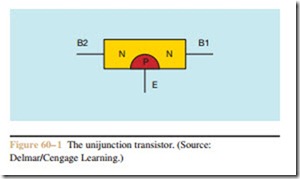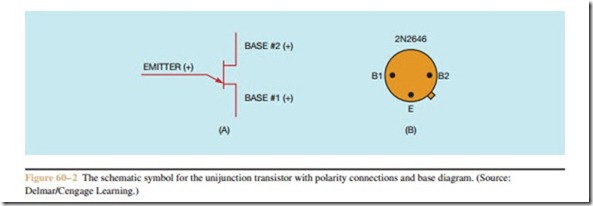THE UNIJUNCTION TRANSISTOR
The unijunction transistor (UJT) is a special transistor that has two bases and one emitter. The unijunction transistor is a digital device because it has only two states, on and off. It is generally classified with a group of devices known as thyristors. Thyristors are devices that are turned completely on or completely off. Thyris tors include such devices as the SCR, the triac, the diac and the UJT.
The unijunction transistor is made by combining three layers of semiconductor material as shown in Figure 60 – 1. Figure 60 – 2 shows the schematic symbol of the UJT with polarity connections and the base diagram.
Current flows in two paths through the UJT. One path is from base #2 to base #1. The other path is through the emitter and base #1. In its normal state,
current does not flow through either path until the voltage applied to the emitter is about 10 volts higher than the voltage applied to base #1. When the voltage applied to the emitter is about 10 volts higher than the voltage applied to base #1, the UJT turns on and current flows through the base #1 – base #2 path and from the emitter through base #1. Current will continue to flow through the UJT until the voltage applied to the emitter drops to a point that is about 3 volts higher than the voltage applied to base #1. When the emitter voltage drops to this point, the UJT will turn off and will re- main off until the voltage applied to the emitter again reaches a level about 10 volts higher than the voltage applied to base #1.
The unijunction transistor is generally connected to a circuit similar to the circuit shown in Figure 60 – 3. The variable resistor controls the capacitor’s rate of charge time. When the capacitor has been charged to about 10 volts, the UJT turns on and discharges the capacitor through the emitter and base #1. When the capacitor has been discharged to about 3 volts, the UJT turns off and permits the capacitor to begin charging again. By varying the resistance connected in series with the capacitor, the amount of time needed for charging the capacitor can be changed, thereby controlling the pulse rate of the UJT (T = RC).
The unijunction transistor can furnish a large output pulse because the output pulse is produced by the discharging capacitor (Figure 60 – 4). This large output pulse is generally used for triggering the gate of a silicon-controlled rectifier.
The pulse rate is determined by the amount of re- sistance and capacitance connected to the emitter of the UJT. However, the amount of capacitance that can be connected to the UJT is limited. For instance, most UJTs should not be connected to capacitors larger than
10 microfarads because the UJT may not be able to handle the current spike produced by a larger capacitor, and the UJT could become damaged.
The unijunction transistor can be tested with an ohmmeter in a manner very similar to that used to test a common junction transistor. (For an explanation of how to test a unijunction transistor, see Procedure 3 in the Appendix.)
When testing the UJT with an ohmmeter, the UJT will appear as a circuit containing two resistors con- nected in series with a diode connected to the junction point of the two resistors as shown in Figure 60 – 5. If the positive lead of the ohmmeter is connected to the emitter of the UJT, a circuit should be seen between emitter and base 1 and emitter and base 2. If the negative lead of the ohmmeter is connected to the emitter, no circuit should be seen between the emitter and either base. If the ohmmeter leads are connected to the two bases, continuity will be seen between these two leads, provided that the output voltage of the ohmmeter is high enough.
1. What do the letters UJT stand for?
2. How many layers of semiconductor material are used to construct a UJT?
3. Briefly explain the operation of the UJT.
4. Draw the schematic symbol for the UJT.
5. Briefly explain how to test a UJT with an ohmmeter.


